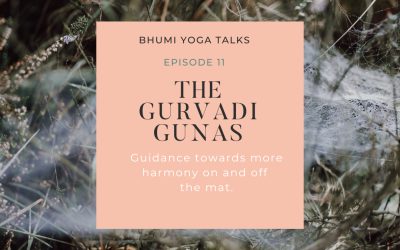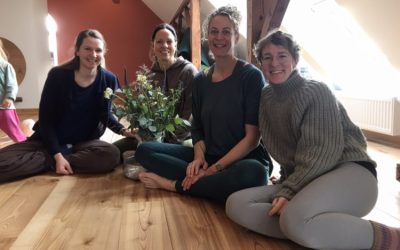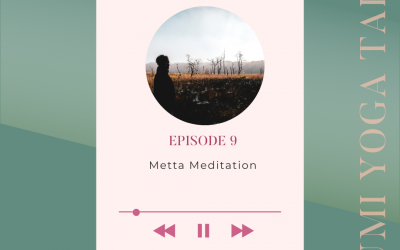Tristana
Harnessing the present experience to still the "monkey mind"On Tristana
Ashtanga yoga is a physical practice of inward concentration. But what does inward concentration actually mean here?
This aspect of the practice is also popping up in the Yoga Sutras, specifically YS2.46 [Shtira Sukam Asanam] – “The asana (as in while being in a pose) for yoga meditation should be steady, without movement, comfortable and stable in order to still the mind”. Stilling the monkey mind from it’s thoughts is one hell of a task, luckily we have the concept of Tristana to help us gain focus and concentration.
Tristana? Yes! Tristana means three-equal standing – on three “areas” that the mind can rest on to bind its attention and awarness. Those three aspects of Tristana are: Gaze, sound of breath and internal alignment.
A little bit about gaze:
(also referred to as drshti)
The gaze creates a gentle space of mind and has a soft, yet steady quaility. The softness of the gaze creates a feeling of compassion. The gaze also allows us to form a relationship between our “inner” and “outer” worlds, as the gaze goes out but also takes in, and assimilates in-and output. The art is to internalize the experience, i.e. not to project your ideas onto what you see, but seeing something as it is, without filters and conditioning; hereby allowing for a relationship between what comes in and out. Then, what you perceive is not as solid anymore, but rather becomes more transient and not to easily to grasp – exposing us to our own processes of conditioning. Of course, this is difficult. That’s were a regular practice comes in, practicing objectivity (is of course not easy, but eventually brings benefits…).
The sound of the breath
The ujjayi breath, that we practice in ashtanga, is that slight constriction of the vocal cords. This subtle constriction allows more concentration to manipulate the flow of our breath. Moderating our breath in a way that the phases of our breath become more consistent; with a consistent peak throughout the entire inhale and exhale, instead of peaking at the middle.
The breath also allows for expansion and making space; we can direct our breath to tense areas consciously, and subtly “create more space”.
The sound of the ujjayi , an aspirant, resonant sound, should be loud enough for yourself to hear but not audible for anyone else. If the sound is too loud, it is unnecessarily dehydrating for the practitioner, as it increases the digestive quality and therefore, takes energy away.
Moreover, the sound increases concentration to not overstrain, and to be present. At the same time, the sound of the breath enables us to feel more attuned / aware of our environment and finding ourselves in space as we move through space (the sound consists of vibrations moving through space).
Inner alignment (bandhas)
Inner alignment awakens us to our body. If things are aligned a certain way, a certain impression in the mind is created and it is more likely to experience unsubjectivity as the mind becomes absorbed into the objects it is observing (i.e. the principles of alignment). Thus, the mind becomes utterly concentrated and absorbed but fuzzy about the self (or the ego) as it becomes more integrated with it’s surroundings.
The more this absorption / integration with one’s surroundings is practiced, the more it becomes an imprint, and thereby, accessible to us, challenging our conditioning (samskaras). Saying this then, if practice is little, there is small residue of this imprinting process. With more (and regular) practice, the relationship between cause and effect (consequences) fatigues; harnessing this, response patters can be adapted.
Altogether, alignment allows us to become aware of inner imprints, being aware of them we can check them and evaluate them.
The concept of Tristana is one example of rooting / anchoring into the presence of what you do and let the mind rest in that presence.
Related News
Lorem ipsum dolor sit amet, consectetur adipiscing elit, sed do eiusmod tempor incididunt ut labore et dolore magna aliqua. Ut enim ad minim veniam, quis nostrud
Bhumi Yoga Podcast – Episode 11
Bhumi Yoga Talks - Episode 11: The Gurvadi Gunas - Guidance towards more harmony on and off the matListen to this talk to learn about how the gurvadi gunas help us bring balance to how and what we do, on and off the mat. You will hear Maxi talk about: What the gurvadi...
The Yoga Groningen – Emden Connection
That's the motto of the Yoga Kula Emden, and it really shines through in how they teach, relate to their yoga students, in their space and how the founders of the Kula hold themselves. About a week agoI traveled with my family to Emden, Germany, where I taught two...
Bhumi Yoga Podcast – Episode 9
For a lot of people this time of year can feel extremely busy and like we are constantly in a rush. Is that you, too? It seems that still a lot "has to get done" before the year comes to an end. There are also various festivities coming up (which can be challenging...




